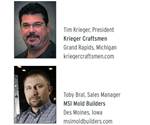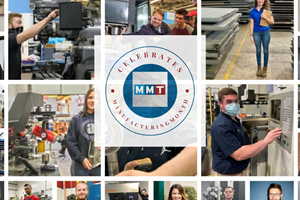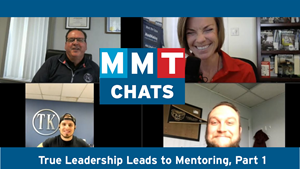Leadtime Leader Q&A: Inspection and Measurement
Moldmaking Technology's 2016 Leadtime Leaders share their views on inspection and measurement.
How extensively do you use inspection and measurement technology in your shop, and where or how do you use it most? Have you invested in any new equipment recently? If yes, tell us about it.
Krieger: I spent a day and a half researching inspection and metrology equipment firsthand during IMTS 2016. It was intriguing to see the world’s finest manufacturers of inspection equipment in one place. I narrowed the decision down to two brands and asked that they each make a presentation to share with my team, whose opinion I greatly value. Following the demonstrations of each product on our molds at the Krieger plant, we invested in a Faro blue light laser scanner and in the reverse engineering software, maintenance and training for both. My vision is to utilize that technology to scan the block before it comes off the machine, inspect it as you go and know that it’s right when it’s delivered for assembly. We don’t have time to rework the rework when delivery seems to always be today, tomorrow, etc.
Bral: We do on-machine inspection of parts, and most of our investments in inspection equipment have been for probes and software to make the inspection process more accurate and efficient. We also have checklists and certain operations that require signatures to make sure items are completed. We continue to research visual inspection equipment to further enhance inspection efficiency and also for reverse engineering purposes. To me, this seems to be the area where scanning systems can be of the most benefit to moldmakers. We often do repair work to molds with no electronic data, and a scanning solution could recreate that data and improve our ability to work on these molds more effectively.
How do you see inspection and measurement tech-nology evolving in the moldmaking industry over the next three to five years?
Krieger: While I don’t want to underestimate the guy who doesn’t have all these fancy systems in place, it’s only going to increase in importance because it’s money—big money—especially when mistakes happen. Therefore, the intent is to attempt to catch mistakes “on the fly” as opposed to finding them when the end product is produced, and avoid additional costs in both time and money, not to mention unnecessary frustration for all involved. Prior to the introduction of standardized measurement to the manufacturing industry, mass chaos occurred and measurement became speculative, and from that, challenges of liability could—and did—arise. Whether you have your own metrology equipment or you have a third-party metrology source that can inspect parts for you, it’s so important to utilize it, and provide evidence of accuracy to valued customers’ engineering teams. It’s also an insurance policy.
Bral: In all honesty, as machines continue to improve in accuracy and quality, and our machining processes and techniques become more robust, I would hope there is a lower reliance on inspection and measurement in the future. Inspection is a non-value-added operation. It’s also not an operation our customers directly pay us to do. If you can cut blocks reliably and know they will come together as intended in the end, there is no need to inspect; but as moldmakers, we need to be sure. The quality check that our customers really care about is that the mold produces the part to print. Whether one side of a shutoff surface is 0.0001-inch heavy and the other side is 0.0001-inch light doesn’t matter to them, as long as it shuts off and the part doesn’t flash. I believe there will always be some level of inspection needed to verify operations were performed correctly, so we won’t totally get away from it
MSI Mold Builders
Related Content
What is Scientific Maintenance? Part 2
Part two of this three-part series explains specific data that toolrooms must collect, analyze and use to truly advance to a scientific maintenance culture where you can measure real data and drive decisions.
Read MoreLeading Mold Manufacturers Share Best Practices for Improving Efficiency
Precise Tooling Solutions, X-Cell Tool and Mold, M&M Tool and Mold, Ameritech Die & Mold, and Cavalier Tool & Manufacturing, sit down for a fast-paced Q&A focused on strategies for improving efficiencies across their operations.
Read More2021 30 Under 30 Honors Program: Mentoring in the Next-Generation of Moldmaking Professionals
Young professionals are vital to the moldmaking industry, and it is important to acknowledge those making strides in shaping the industry's future. MoldMaking Technology recognizes the industry's young talent through its 30 Under 30 Honors Program.
Read MoreICYMI: MMT Chats: True Leadership Leads to Mentoring, Part 1
This trio from TK Mold and Engineering in Romeo, Michigan, joins me to discuss the role of leadership and culture in mentorship. This episode is brought to you by ISCAR with New Ideas for Machining Intelligently.
Read MoreRead Next
Leadtime Leader Q&A: Krieger Craftsmen and MSI Mold Builders
We invited last year’s Leadtime Leader winner and honorable mention shops to share some of their thoughts about some hot industry topics.
Read MoreHow to Use Strategic Planning Tools, Data to Manage the Human Side of Business
Q&A with Marion Wells, MMT EAB member and founder of Human Asset Management.
Read MoreHow to Use Continuing Education to Remain Competitive in Moldmaking
Continued training helps moldmakers make tooling decisions and properly use the latest cutting tool to efficiently machine high-quality molds.
Read More














.jpg;maxWidth=300;quality=90)


_300x250 1.png;maxWidth=300;quality=90)







